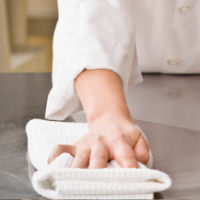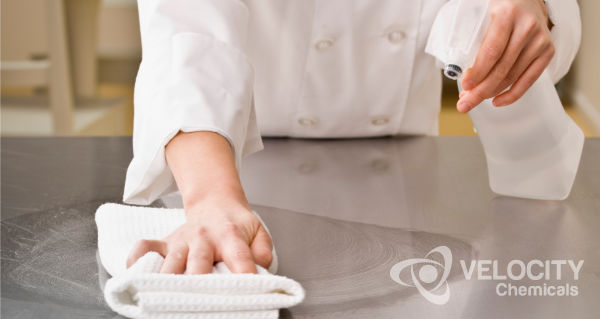COVID19: Why Understanding Cleaning Versus Disinfecting Is Vital

Since the start of the COVID19 crisis, even rigorous cleaning has been proven insufficient to hold back the spread of novel coronavirus. Disinfecting is confirmed as essential to making surfaces hygienically safe. As the hospitality industry reopens, understanding cleaning versus disinfecting is important if it is to be done safely and the COVID19 crisis is to end.
Throughout Canada, lockdown restrictions are slowly being lifted, allowing businesses to reopen and people to return to work. But the risk of a COVID19 resurgence has not gone. For that reason, businesses must adhere to strict new protocols if they are to adequately protect employees and customers alike from the risk of infection.
The hospitality, food and beverage, and catering industries are amongst the most at-risk sectors due to the nature of the businesses themselves. Restaurants, cafes, pubs and other operators must ensure physical distancing, with tables and seating spaced at least 2 metres apart, on-premises traffic flow (for employees as well as customers) marshalled carefully and services adapted to ensure minimal interaction at close quarters.
And while cleaning protocols have been enhanced, disinfecting surfaces is the new priority. But what is the distinction between ‘clean’ and ‘disinfected’? And why has cleaning versus disinfecting become so important to understand?
Understanding Cleaning Versus Disinfecting
On the face of it, there is little difference between the two – but in fact, there are several. Simply put, it comes down to whether microbial organisms and pathogens are permitted to survive or not. Importantly, the health consequences for either can be significant, especially when dealing with pathogens like COVID19.
Cleaning- Cleaning focuses on removing visual soils, like dust, debris and dirt.
- Soap and water is all that is needed to clean a surface.
- Bacteria and viruses are not fully removed. Only a percentage is washed away along with the dirt and grime.
- Cleaning thoroughly may be enough when dealing with low-touch surfaces, like floors and windows. This is because the likelihood of individuals touching these surfaces is low therefore making pathogen transfer low.
- With cleaning, COVID19 has been shown to survive.
Disinfecting
- Disinfecting kills both bacteria and viruses on hard, non-porous surfaces.
- Because pathogens are destroyed, it offers the most complete protection against COVID19.
- Disinfection is achieved through chemical disinfectants with active ingredients scientifically proven to kill pathogens, like influenza, rhinovirus, norovirus and coronavirus etc.
- The most effective ingredients in disinfectants include:
-
- Quaternary Ammonium
- Ethanol alcohol (60%-90%)
- Isopropyl alcohol (60%-90%)
- Hydrogen peroxide
- Sodium hypochlorite
-
- Not all disinfectants kill all pathogens, which is why it is important to check the effectiveness of a disinfectant against COVID19 (also known as SARS-CoV-2)
- Effective disinfectants are approved by recognised bodies. In Canada, it is Health Canada; check Drug Identification Numbers (DIN) against its official list. In the US, the CDC and EPA.
What About Sanitizing?
Sanitizing is another important word in this context. A sanitized surface is one that has a vastly reduced number of bacteria on the surface – with many products claiming to remove as much as 99.9%. However, viruses may still survive on a sanitized surface, making disinfecting more reliable.
Still, research carried out by the WHO has shown that alcohol-based hand sanitisers with at least 60% alcohol content are effective against the coronavirus. The high alcohol content is known to kill viruses similar to COVID19 but the WHO’s proved it is a practical alternative to soap and water.

Velocity Chemicals Products Leading The COVID19 Fight
VELOSAN is a quaternary ammonium compound that cleans, disinfects and deodorizes hard surfaces at the same time. Its non-acidic formula is less corrosive than bleach while its all-in-one formulation replaces the need for multiple products.
It is recognised as likely to be effective against the COVID-19 virus and is included on the Health Canada list of recommended disinfectants (DIN# 02280825).
- custom chemical formulation – ensures your specific needs are met without compromising on efficacy
- just add water – recommended dilution rate means 1 Litre of concentrated formula make 16 bottles.
- keeps shipping and supply costs down – available in 4 Litre jugs, 20 Litre pails or drums, and 1,000 Litre totes
VELOSAN is available from our approved distributors and directly from Velocity Chemicals, with orders shipped to anywhere in Canada within 24 hours. To order, call one of our specialists today at toll-free 1-888-963-9499.
Tags: Cleaning, COVID19, Disinfecting




